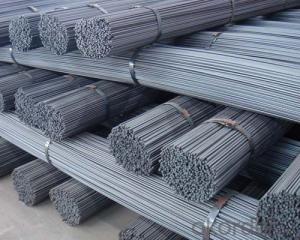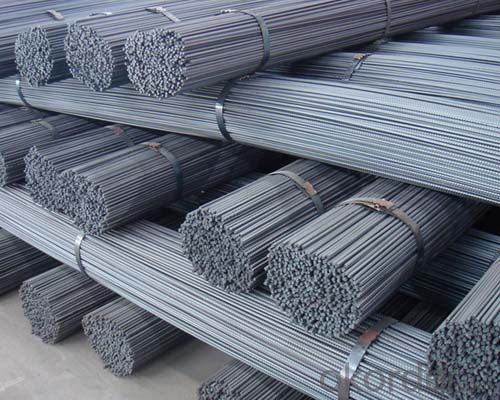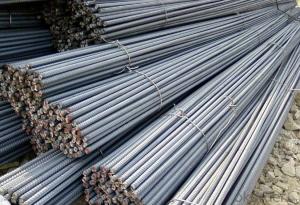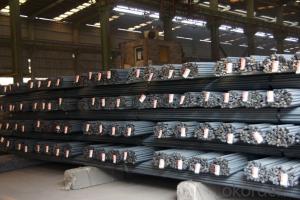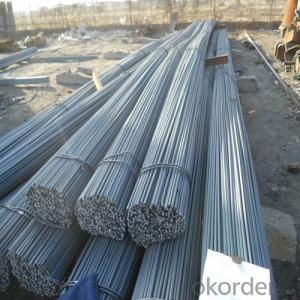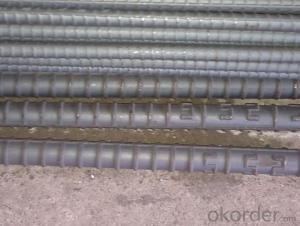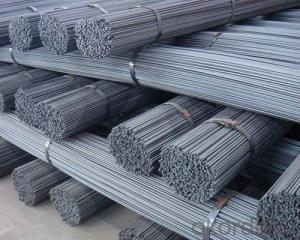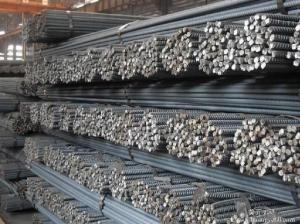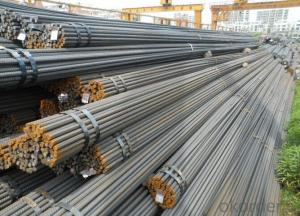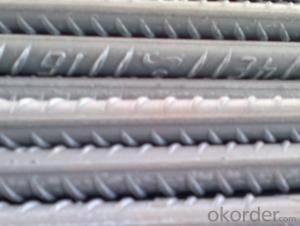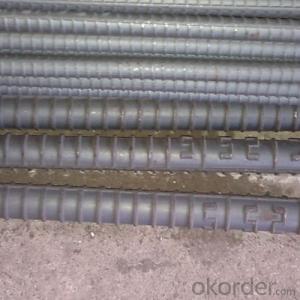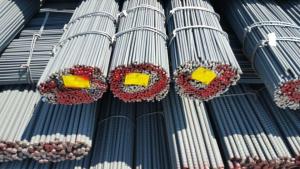Reinforcing Deformed Steel Bars with Grade HRB400-HRB500
- Loading Port:
- Tianjin
- Payment Terms:
- TT OR LC
- Min Order Qty:
- 25 m.t.
- Supply Capability:
- 20000 m.t./month
OKorder Service Pledge
OKorder Financial Service
You Might Also Like
Specification
OKorder is offering high quality Hot Rolled Rebars at great prices with worldwide shipping. Our supplier is a world-class manufacturer of steel, with our products utilized the world over. OKorder annually supplies products to Africa, North American and Asian markets. We provide quotations within 24 hours of receiving an inquiry and guarantee competitive prices.
Product Applications:
Deformed bar is widely used in buildings, bridges, roads and other engineering construction. Big to highways, railways, bridges, culverts, tunnels, public facilities such as flood control, dam, small to housing construction, beam, column, wall and the foundation of the plate, deformed bar is an integral structure material. With the development of world economy and the vigorous development of infrastructure construction, real estate, the demand for deformed bar will be larger and larger.
Product Advantages:
OKorder's Hot Rolled Rebars are durable, strong, and resist corrosion.
Main Product Features:
· Premium quality
· Prompt delivery & seaworthy packing (30 days after receiving deposit)
· Corrosion resistance
· Can be recycled and reused
· Mill test certification
· Professional Service
· Competitive pricing
Product Specifications:
Manufacture: Hot rolled
Grade: HRB400 – HRB500
Certificates: ISO, SGS, BV, CIQ
Length: 6m – 12m, as per customer request
Packaging: Export packing, nude packing, bundled
Grade | Technical data of the original chemical composition (%) | ||||||
C | Mn | Si | S | P | V | ||
HRB400 | ≤0.25 | ≤1.60 | ≤0.80 | ≤0.045 | ≤0.045 | 0.04-0.12 | |
Physical capability | |||||||
Yield Strength (N/cm²) | Tensile Strength (N/cm²) | Elongation (%) | |||||
≥400 | ≥570 | ≥14 | |||||
Theoretical weight and section area of each diameter as below for your information:
Diameter(mm) | Section area (mm²) | Mass(kg/m) | Weight of 12m bar(kg) |
6 | 28.27 | 0.222 | 2.664 |
8 | 50.27 | 0.395 | 4.74 |
10 | 78.54 | 0.617 | 7.404 |
12 | 113.1 | 0.888 | 10.656 |
14 | 153.9 | 1.21 | 14.52 |
16 | 201.1 | 1.58 | 18.96 |
18 | 254.5 | 2.00 | 24 |
20 | 314.2 | 2.47 | 29.64 |
22 | 380.1 | 2.98 | 35.76 |
25 | 490.9 | 3.85 | 46.2 |
28 | 615.8 | 4.83 | 57.96 |
32 | 804.2 | 6.31 | 75.72 |
36 | 1018 | 7.99 | 98.88 |
40 | 1257 | 9.87 | 118.44 |
50 | 1964 | 15.42 | 185.04 |
FAQ:
Q1: Why buy Materials & Equipment from OKorder.com?
A1: All products offered by OKorder.com are carefully selected from China's most reliable manufacturing enterprises. Through its ISO certifications, OKorder.com adheres to the highest standards and a commitment to supply chain safety and customer satisfaction.
Q2: How do we guarantee the quality of our products?
A2: We have established an advanced quality management system which conducts strict quality tests at every step, from raw materials to the final product. At the same time, we provide extensive follow-up service assurances as required.
Q3: Can you offer the third part inspection certificates ?
A3: Yes, we can apply third part inspection before shipping, such as SGS, BV, etc .
Images
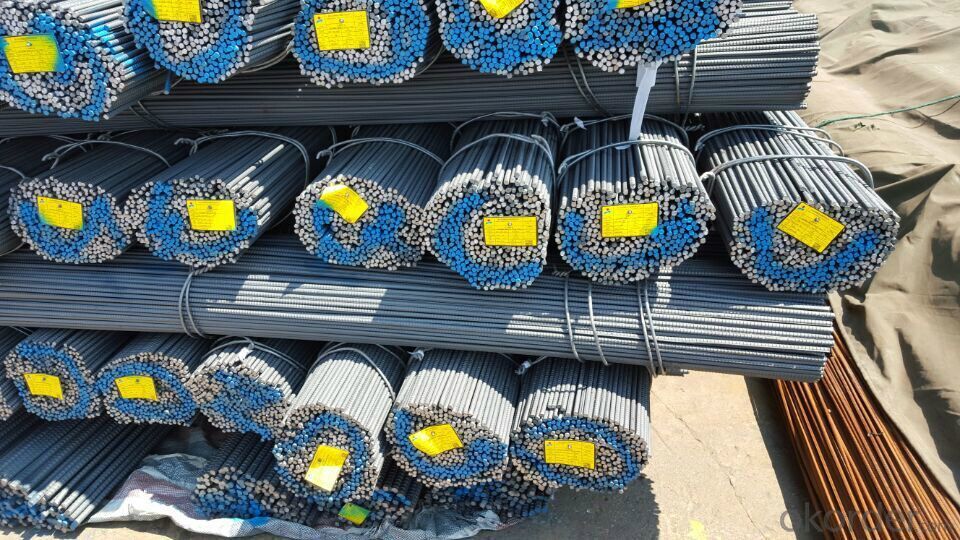
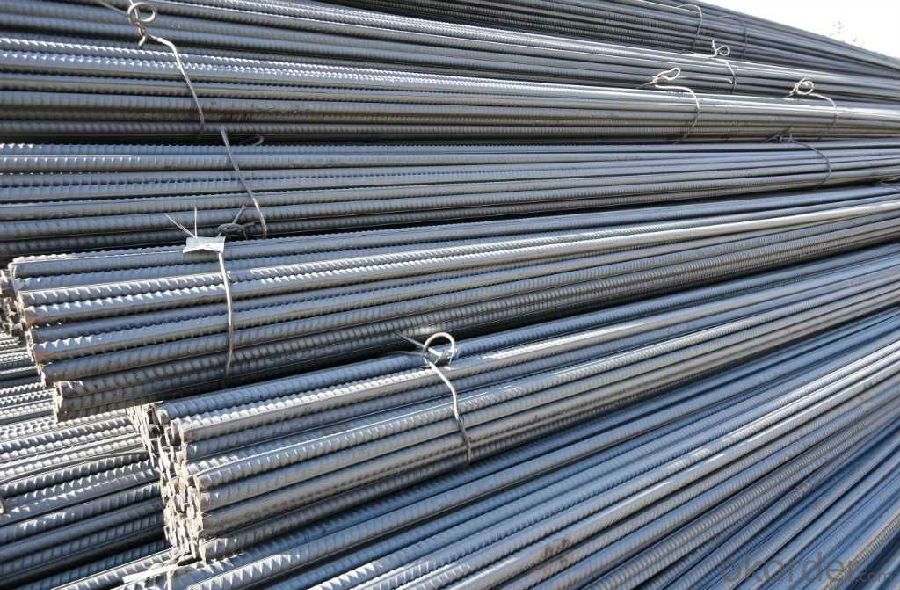
- Q: What is the national standard of thread steel No. 8?
- Steel is known as hot rolled ribbed bar. The rebar is a kind of small section steel, mainly used for the skeleton of reinforced concrete construction members. In use, some mechanical strength, bending deformation property and welding performance are required.
- Q: How are steel rebars bent or shaped according to construction needs?
- Steel rebars are bent or shaped according to construction needs through a process called rebar bending. This is typically done using specialized machinery, such as rebar benders or bar bending machines. The rebars are placed in the machine, and hydraulic or mechanical force is applied to bend them into the desired shape or angle. The bending process ensures that the rebars fit perfectly into the designated areas of the construction project, providing structural support and reinforcing concrete structures.
- Q: How are steel rebars protected from fire damage?
- Steel rebars are typically protected from fire damage through the application of fire-resistant coatings or by encasing them within fire-resistant materials, such as concrete. This helps to prevent the steel rebar from reaching its critical temperature, which could compromise its structural integrity.
- Q: Grade 1, grade three, grade two, steel, wire rod, round bar
- Steel is commonly known as hot rolled ribbed bar, belonging to the small steel steel, mainly used for steel reinforced concrete structure frame. In use, some mechanical strength, bending deformation property and welding performance are required. The raw steel billet for the production of threaded steel is carbon structural steel or low alloy structural steel which is treated by calm melting, and the finished steel bar is delivered in hot rolling forming, normalizing or hot rolling state.
- Q: Can steel rebars be used in structures with high resistance to creep?
- Yes, steel rebars can be used in structures with high resistance to creep. Steel rebars are commonly used in reinforced concrete structures and provide strength and durability to the overall structure. Creep is the gradual deformation of a material under constant stress over time. While steel does exhibit some creep, it is considered to have a low creep rate compared to other materials such as concrete or timber. Additionally, the use of rebars in reinforced concrete structures can help distribute the load and minimize the effects of creep by adding stiffness and reducing the overall stress on the concrete. Therefore, steel rebars can be effectively used in structures with high resistance to creep when designed and installed properly.
- Q: What are the advantages of using steel rebars in construction?
- Steel rebars offer several advantages in construction. Firstly, they provide strength and durability to reinforced concrete structures, making them capable of withstanding heavy loads and extreme weather conditions. Secondly, steel rebars have excellent tensile strength, allowing them to absorb and distribute stress more effectively, preventing concrete from cracking or breaking under tension. Additionally, steel rebars can be easily fabricated and shaped to fit specific project requirements, providing flexibility in design. They also offer corrosion resistance, ensuring the longevity and integrity of the structure. Overall, the use of steel rebars enhances the structural integrity, safety, and longevity of construction projects.
- Q: What is the minimum ductility requirement for steel rebars?
- The minimum ductility requirement for steel rebars is typically set at 14.5%.
- Q: What are the guidelines for cutting and bending steel rebars on-site?
- To ensure safety and accuracy when cutting and bending steel rebars on-site, it is essential to adhere to specific guidelines. These guidelines play a crucial role in maintaining the structural integrity of the rebars. Here are some key considerations to keep in mind: 1. Prioritize safety: Before initiating any cutting or bending activities, it is imperative to prioritize safety. This involves wearing appropriate personal protective equipment (PPE) such as goggles, gloves, and steel-toe boots. Additionally, ensure that the work area is free from hazards and that all safety protocols are followed. 2. Utilize appropriate cutting tools: When cutting rebars, it is important to use high-quality cutting tools specifically designed for this purpose. Commonly used manual cutting tools include bolt cutters or hydraulic shears. It is crucial to ensure that the cutting tool is sharp and in good condition to achieve clean cuts. Avoid using torches or heat-based methods, as they can weaken the rebars. 3. Precise measurement and marking: Before cutting, it is essential to measure and mark the rebars accurately according to the required lengths. To ensure accuracy, utilize a measuring tape and a permanent marker. Double-check the measurements to avoid any mistakes that may result in wastage or improper reinforcement. 4. Employ proper bending tools: When bending rebars, it is vital to use appropriate bending tools or machines. These tools ensure accurate bending angles and minimize the risk of rebars breaking or cracking. Adhere to the bending specifications provided by the project engineer or local building codes to ensure compliance. 5. Familiarize with reinforcement requirements: Gain a thorough understanding of the reinforcement requirements by reviewing the project plans, drawings, and specifications. Different projects may have specific guidelines for cutting and bending rebars. It is crucial to adhere to these requirements to ensure correct installation and provide the necessary structural strength. 6. Maintain quality control: Regularly inspect the rebars during the cutting and bending process to verify that they meet the required standards. Look for any signs of damage, cracks, or substandard workmanship. Additionally, ensure that the rebars are appropriately sorted and stored to prevent mix-ups or confusion on-site. 7. Effective waste management: Implement proper waste management practices for the waste generated during the cutting and bending process. Collect and dispose of steel shavings or offcuts in designated containers to prevent injuries or accidents caused by sharp edges. In conclusion, adhering to these guidelines for cutting and bending steel rebars on-site will contribute to the safety, accuracy, and effectiveness of the reinforcement process. When in doubt or faced with specific project requirements, it is advisable to consult experienced professionals or the project engineer.
- Q: How do steel rebars contribute to the load-bearing capacity of a structure?
- Steel rebars contribute to the load-bearing capacity of a structure by reinforcing the concrete and increasing its strength and durability. They provide tensile strength, which helps the structure resist bending and cracking under heavy loads, making it more resistant to structural failure.
- Q: How do steel rebars improve the load-carrying capacity of concrete?
- Steel rebars improve the load-carrying capacity of concrete by providing additional tensile strength. When concrete is subjected to heavy loads or forces, it tends to crack under tension. The inclusion of steel rebars within the concrete helps to counteract this weakness by absorbing the tensile forces and distributing them throughout the structure. This reinforcement enhances the overall durability and structural integrity of the concrete, allowing it to bear heavier loads without failing.
Send your message to us
Reinforcing Deformed Steel Bars with Grade HRB400-HRB500
- Loading Port:
- Tianjin
- Payment Terms:
- TT OR LC
- Min Order Qty:
- 25 m.t.
- Supply Capability:
- 20000 m.t./month
OKorder Service Pledge
OKorder Financial Service
Similar products
Hot products
Hot Searches
Related keywords
